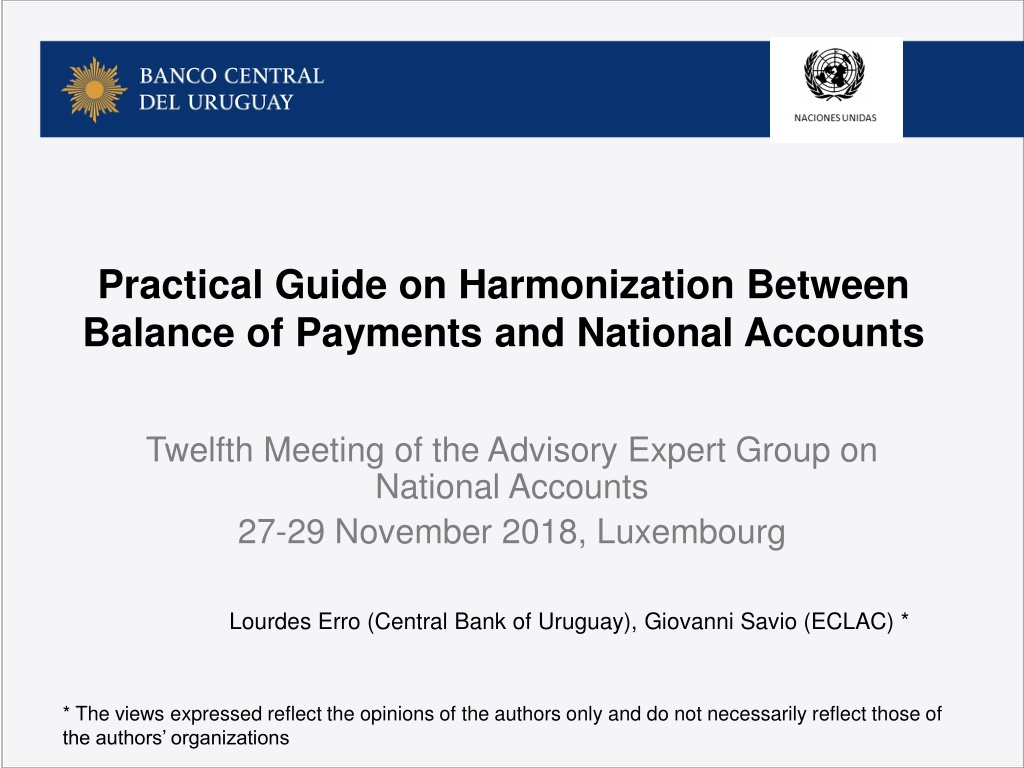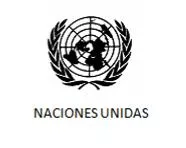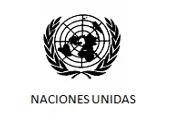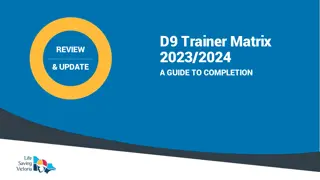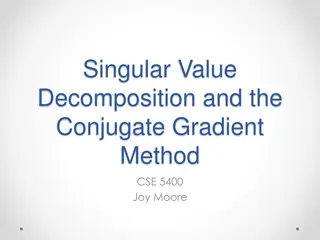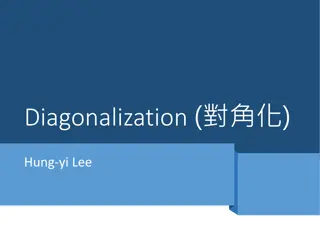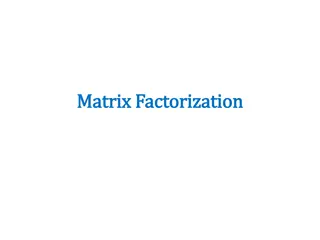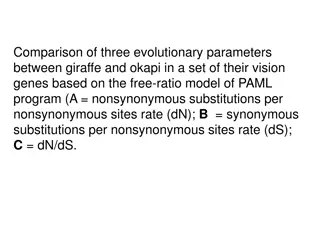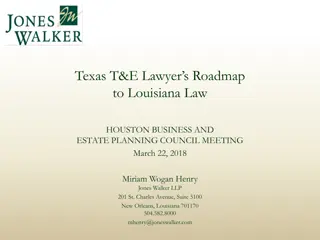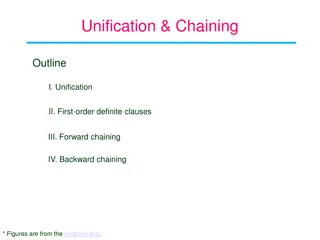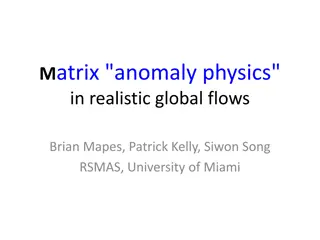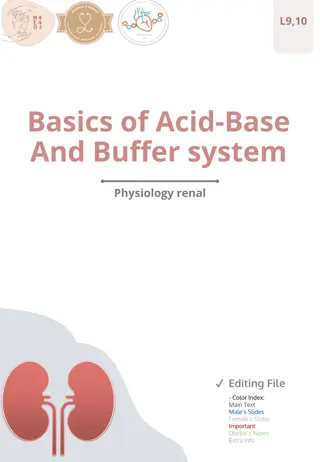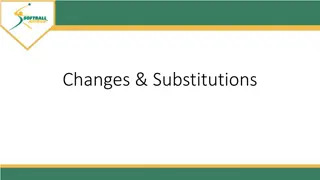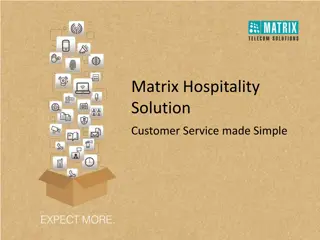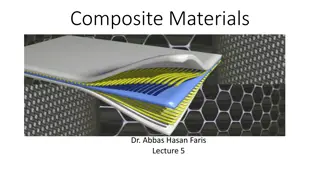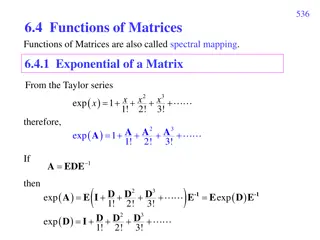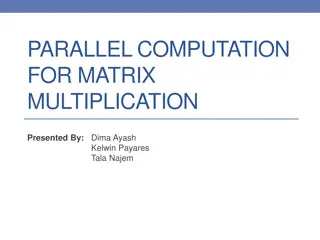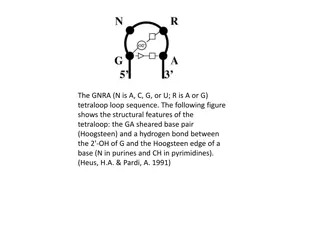Matrix Models of Base Substitutions II
Review of Markov models, eigenvalues, and eigenvectors in the context of base substitutions. Explore the geometric meaning of eigenvalues and eigenvectors, along with the application of transition matrices in estimating base distribution vectors. Dive into the fundamental assumptions of Markov models and the mathematical implications they hold.
Download Presentation

Please find below an Image/Link to download the presentation.
The content on the website is provided AS IS for your information and personal use only. It may not be sold, licensed, or shared on other websites without obtaining consent from the author.If you encounter any issues during the download, it is possible that the publisher has removed the file from their server.
You are allowed to download the files provided on this website for personal or commercial use, subject to the condition that they are used lawfully. All files are the property of their respective owners.
The content on the website is provided AS IS for your information and personal use only. It may not be sold, licensed, or shared on other websites without obtaining consent from the author.
E N D
Presentation Transcript
Practical Guide on Harmonization Between Balance of Payments and National Accounts Twelfth Meeting of the Advisory Expert Group on National Accounts 27-29 November 2018, Luxembourg Lourdes Erro (Central Bank of Uruguay), Giovanni Savio (ECLAC) * * The views expressed reflect the opinions of the authors only and do not necessarily reflect those of the authors organizations
Presentation Outline 1. Regional Working Group (RWG) on BoP and NA Harmonization 2. The approach: Integrated Economic Statistics 3. Organization of the Guide Chapter 1: Conceptual compliance Chapters 2 and 3: Statistical production process Chapter 4: Institutional arrangements 4. Conclusions
1. The RWG The underlying methodology and concepts for NA (2008 SNA) and BoP (BPM6) are consistent But: large differences remain in practice An initial evaluation of BoP and NA data presented at the 2016 UN-ECLAC National Accounts Seminar showed large inconsistencies Countries expressed interest in further working to better understand the reasons for such inconsistencies and improve the harmonization in practice They created an RWG with this purpose During the 11thmeeting (Dec. 2017) the AEG stressed the importance of the harmonization and supported regional initiatives developed in LAC and Europe The Guide is the main outcome of the activities of the RWG
1. The RWG RWG on Harmonization BOP - NA Colaboration from other Experts (IMF, Eurostat) Argentina Work carried out from July 2017 to July 2018 Brasil Colombia Annual Seminar on National Accounts (ECLAC) Costa Rica Guatemala RWG UN-ECE Meeting of the Group of Experts on NA Nicaragua Uruguay Technical Support: UNSD- UN-ECLAC AEG COORDINATION Venezuela Participants were for each country: one expert on NA and one expert on BOP
2. The approach of Integrated Economic Statistics () The Group adopted the approach of Integrated Economic Statistics to review reasons for lack of harmonization, look for best practices and make recommendations Building blocks 1. Conceptual compliance (Use the same conceptual framework ) 2. Statistical production process (Follow a coherent process of statistical production in both systems) 3. Institutional arrangements UNSD, DESA, NY 2013 (Institutional setting of the coordination)
Chapter 1: Conceptual compliance USE THE SAME CONCEPTUAL FRAMEWORK POTENTIAL ELEMENTS FOR INCONSISTENCIES Although the frameworks are conceptually consistent, there are differences in wording, emphasis and topics covered, which might generate different interpretations in compilers and results not totally aligned The Guide focuses on special issues that were introduced by 2008 SNA and BPM6 to achieve consistency Those cases are discussed in Chapter I, Section C of the Guide Different moments of 2008 SNA and BPM6 implementations at the national level
Chapter 1: Conceptual compliance CONTRIBUTIONS AND RECOMMENDATIONS The Guide presents: correspondence tables between accounts, codes and denominations of BoP and the RoW account (from BoP to RoW and from RoW to BoP) changes that were introduced by 2008 SNA and BPM6 to achieve, amongst others, consistency: center of predominant economic interest change of residence goods for processing merchanting branches of non-resident units multi-territorial companies special purpose entities The Guide recommends to pay attention to the coordinated implementation of these special issues
Chapter 1: Conceptual compliance CONTRIBUTIONS AND RECOMMENDATIONS The Guide recommends: to coordinate common times for the implementation and publication of data following BPM6 and 2008 SNA, so as to minimize differences due to this reason although probably this could delay implementation for some recommendations
Chapters 2-3: Statistical Production Process FOLLOW A STATISTICAL PRODUCTION PROCESS COHERENT WITH EACH OTHER, FROM DATA SOURCES TO DISSEMINATION POTENTIAL ELEMENTS FOR INCONSISTENCIES Business registers: no common business registers different scope and classification of institutional units different frames for sampling Data sources and data processing: uncoordinated and inconsistent use of data different coverage different methods used in data processing (e.g. imputations for underreporting, estimations of flows denominated in different currencies, adjustments for valuation, etc.) Integration of statistics and accounts: use of different reconciliation frameworks Dissemination and communication: uncoordinated policies of dissemination, release calendars and revision policies
Chapter 4: Institutional arrangements COORDINATION HAS TO BE INSTITUTIONALLY SET POTENTIAL ELEMENTS FOR INCONSISTENCIES Obstacles in coordinating the compilation process and reconciling discrepancies (greater in countries where BoP and SNA are compiled in different institutions) Lack of established institutional mechanisms: Working Groups, Committees, MoUs etc.
Chapter 4: Institutional arrangements RECOMMENDATIONS For the compilation of BoP and NA to become an integrated statistical process, an appropriate institutional framework is required Most important guidelines might be: To maintain a clear vision of the integrated process (institutionally agreed) To agree on a clear division of tasks : who does what, as well as the institutional responsibilities in the process To formalize mechanisms of coordination and governance (committees, working groups, MoUs, service agreements, etc.) To use planning and management tools, such as the establishment of a Medium-term Strategic Harmonization Plan
5. Conclusions The Guide, as such, is not in its final form: it is also in the process of translation to English The experience of the RWG allowed to identify some best practices, also based on regional case studies, and to make some concrete recommendations But there is still a lot of space for improvement, especially in concrete applications at the regional level The most valuable experience was the exchange of concrete good practices of harmonization applied at the country level
